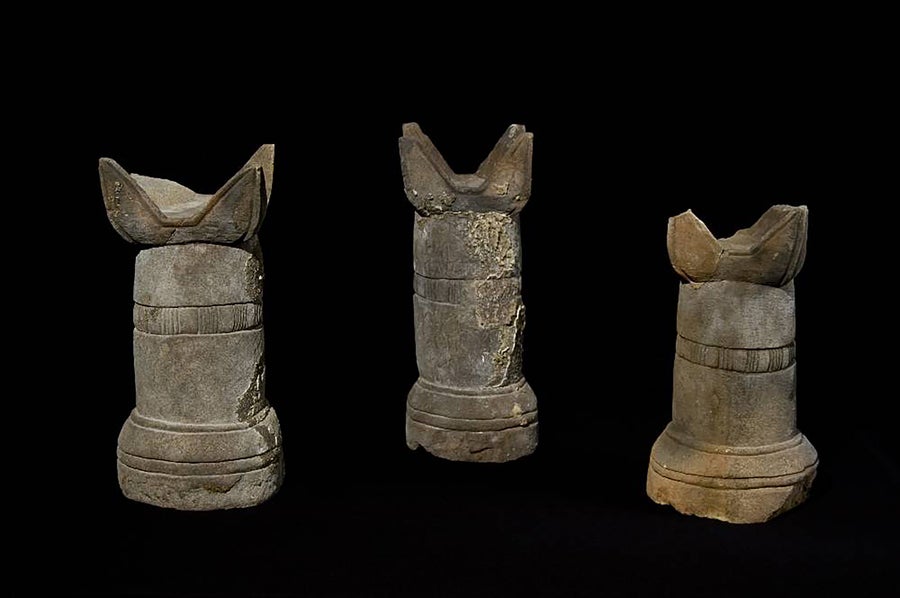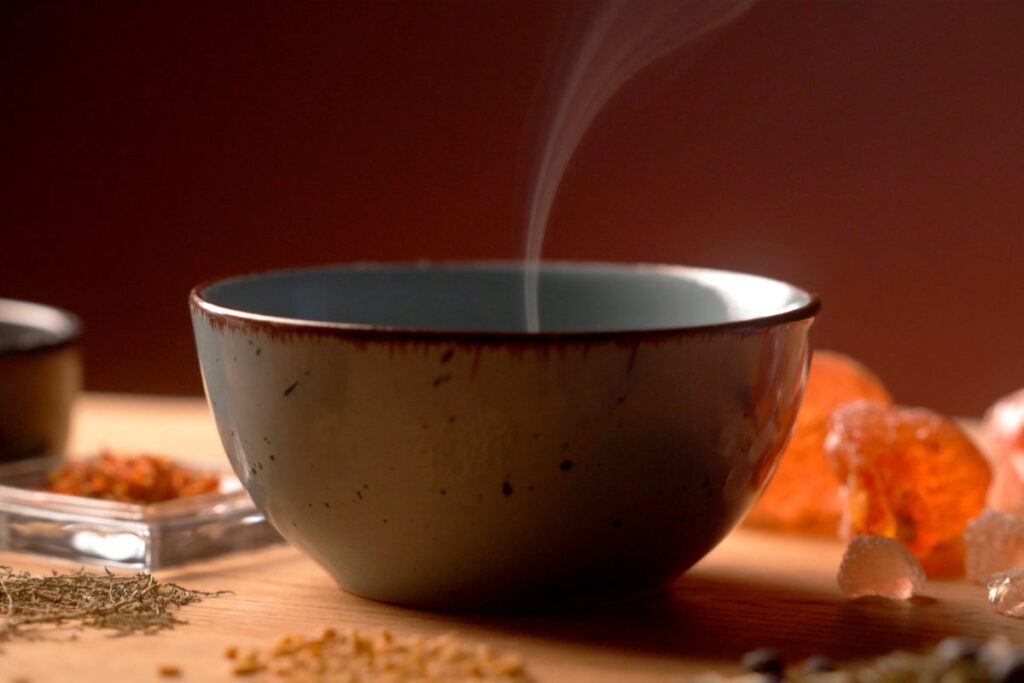What’s the first thing you notice when you step into a museum? Is it the long-faded colors of ancient artifacts from all around the world or the hushed sounds of visitors discussing what they see? Maybe there’s a replica of scratchy old fabric you can touch. Some locations might even offer an edible treat inspired by an ancient recipe. Museums allow us to indirectly “experience” the past by tapping into our primary senses—sight, hearing, taste, touch—but more often than not, smell is missing.
The past often gets presented to us as odorless. But that overlooks the huge roll smell likely played in many historical realities, says Barbara Huber, an archaeochemist at the Max Planck Institute of Geoanthropology in Jena, Germany. The frequent absence of scent (not counting the musty tang of many museums) in our study of history has inspired Huber and a growing community of chemists and archaeologists to track down some molecular remnants that can let us smell the past. For example, she created “Scent of the Afterlife,” a mix of scents that captures the range of smells that would have accompanied mummification processes in ancient Egypt.
READ MORE: What Sniffing Mummies Taught Scientists about an Ancient Society
On supporting science journalism
If you’re enjoying this article, consider supporting our award-winning journalism by subscribing. By purchasing a subscription you are helping to ensure the future of impactful stories about the discoveries and ideas shaping our world today.
Some of the recent advances in the quest to catch a whiff of history are featured in the new bookScents of Arabia: Interdisciplinary Approaches to Ancient Olfactory Worlds, co-edited by Huber. Scientific American spoke to her about the “science of smell” and its significance to our understanding of lives long gone.
[An edited transcript of the interview follows.]
We know that smell is linked to very specific areas of the brain. What are these areas? And why does that link make olfactory interactions so important throughout history?
The sense of smell is very much linked to the parts in our brain that process emotion and memory. There’s also a very direct link from our olfactory bulb in the nose to the amygdala and the hippocampus, so we actually react to something that we smell before we even think about it. And this concept is something that comes from a very long evolutionary tradition. Our ancestors basically needed this ability to memorize specific smells because that also alerted them to danger.
I think, nowadays, we do not really think about how it has a major effect on how we perceive and navigate the world. And it has a huge effect on our well-being—an interesting fact that COVID told us again because people relearned how important the sense of smell was when they lost it.
Glass vials hold samples of ancient incense burners for chemical testing.
And we don’t really think about smell [when studying the past]. One of the problems is because, from a methodological point of view, it is incredibly hard to study. The scents and smells and stenches—whatever was there in the past—had already been gone before archaeologists could come and study the sites. Only new chemical and biomolecular methods in archaeology have kind of reopened the door to continue to study these things. And of course, what we have from ancient texts can also help a lot.
When we do find all these details, they can really enrich our understanding of a lot of aspects of past ways of life, from medicine to perfumery and cosmetics to trade but also things like identity or social status. There were wars over spices—these tiny powders and resins had such a strong effect on people that they went to war for them!
Something that’s really fascinating to me about smell is that, in a way, it’s tangible and intangible. Even though we can’t directly smell the past, there’s a lot we can know about how things might have smelled, as with Scent of the Afterlife. How has studying something with that kind of duality changed your perspective on doing research?
The interesting thing about smell is that these molecules that we detect, or that we are still able to detect, can tell us a lot about ancient materials. At the same time, when we reconstruct and recreate them like we did with Scent of the Afterlife, we can also actually bring a piece of the past to visitors today. And that’s not just having an object that has been found and excavated, then displaying it in a museum. [In a scent exhibit], people can actually perceive it. This way of perception is kind of “participating” in the past. If you enter a room and you can actually smell how it must have smelled in an ancient mummification room in ancient Egypt—and you see all the raw materials and everything—then you’re in a different way being immersed in history and in learning.
There have also been studies that show that this multisensory way of learning—especially smell—can actually enhance how you think about specific things and enhance learning effects. And I think it’s because it’s so connected to emotions. When you are at an exhibition, you might recollect memories when you smell something that is connected very much to yourself. It connects us deeper to earlier ways of life.
Really interesting that you mention that because I was just thinking back to Scent of the Afterlife, the perfume you reconstructed from ancient Egyptian mummies, and the way everyone at SciAm was thinking about the sample we had. My colleagues’ descriptions referred to very specific experiences from their own life—for example, I said that it smelled like a very well-managed “grandpa car.”
[Laughs.] That’s brilliant.
I’d love to hear more about the nitty-gritty science involved in doing the kind of analysis needed to re-create smells like this.
We work with organic materials. Sometimes the original substance is not even there [anymore]—but what we do is: we look for what we call scent archives. So these are specific objects—for example, a perfume flask or a cosmetic container or an incense burner—that are related to the kind of practices or actions that require scented materials. Let’s say you have a scented cream, and there are remains of that, a crust or something like that, in your pot. Then we can take tiny amounts of samples and do an analysis on that. We first identify all the different compounds of the sample with gas chromatography to separate all the different molecules that are in the sample, then analyze it with mass spectrometry [an analytic method that identifies an unknown chemical compound by studying its spectral behavior]. Then, basically, we’re able to identify every single compound.
And it gives us clues about trade, for instance. If we find all the different ingredients and look at whether these ingredients are local, can people just go out there and harvest them? Or do they need to import them from distant lands?
How does decomposition affect the process? From what I understand, the compound you detected might not have been the original compound.
Let’s take, say, vanillin. This is a molecule that has this vanillalike scent. And when we find vanillin, you might jump to the conclusion and say, “Oh, my God, we have vanilla! Oh, cool! They used vanilla in the past!” But vanillin is also a decomposition product of a larger molecule, which is called lignin, which is a very common decomposition product of woody tissue. So a lot of wooden things actually have this vanillin compound when they break down. And so, when you find this, you need to be very careful because it doesn’t always mean there is only one possibility from where it could come. There is a lot of detective work on our side to analyze what we have and try to make sense out of it.
Something that I found really interesting about the introduction to Scents of Arabia was the bit about how this book “challenges traditional trade-focused narratives.” What is meant by “trade-focused narratives”? And how does the book challenge that?
In the study of ancient materials—especially aromatic materials in Arabia—the study of trade and the incense road [a trade network covering a broad area from the Arabian Peninsula to the Mediterranean and mostly dealing with the circulation of incense] was always an interesting point for researchers. But the problem is that the incense road was very often looked at from the perspective of classical scholars—so texts from ancient Greece or ancient Rome. From the very beginning, the story of the incense road was told by outsiders, who were also not really contemporary. We don’t really have any evidence from the earlier periods, the Iron Age and the Bronze Age in ancient Arabia. So for us, it was very interesting to look at evidence other than ancient texts that can tell us a little bit more about the trade of aromatics.

Examples of ancient incense burners from the Oasis of Tayma in what is now Saudi Arabia.
M. Cusin/Orient Department, German Archaeological Institute/“Incense Burners at the Oasis of Tayma, Northwest Arabia: An Olfactory Perspective,” by Barbara Huber, in Polish Archaeology in the Mediterranean, Vol. 29, No. 1. December 30, 2020 (CC BY 3.0 PL)
Is there a particular chapter or case study that comes to mind when you think about the overall framework or objectives of the anthology?
In one case study, we looked at the content of incense burners and found a plant called Peganum. The common name is Syrian rue, and it’s a medicinal and psychoactive plant. So we realized that in these incense burners, specifically, people actually used it for therapeutic or psychoactive purposes. This was very interesting because the practice of incense burning seems to not only be sensorial but also have this medicinal component.
The close study of these incense burners actually revealed something where we had absolutely no idea: medicinal practices in Arabia before the Islamic period. We, all of a sudden, had an idea of how people used their local pharmacopoeia [archival document of medicinal ingredients issued by the government] for treating illnesses; [in this case] they burned it and then probably inhaled the smoked—and not just applied it to the skin or drank it as an infusion.
The practice of burning incense, which is very linked to Arabia—there is the incense road and emblematic scents, such as frankincense and myrrh—left a legacy that is still alive today. It’s part of people’s lives today, but it goes all the way back. And we [in the book] basically follow it to the roots of where it began, how it shaped societies and the identity of a particular part of the world—and of course, how it is still connected.
For me, the collection reminds me that history isn’t something that we only see.

